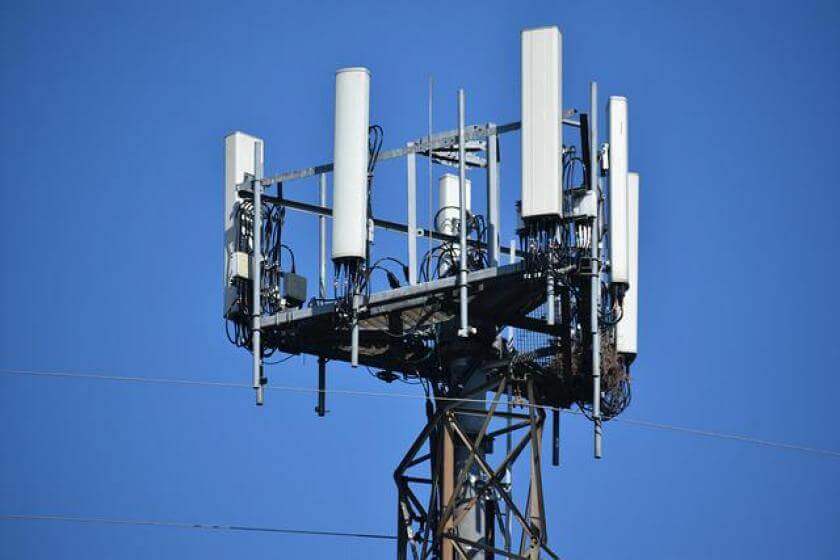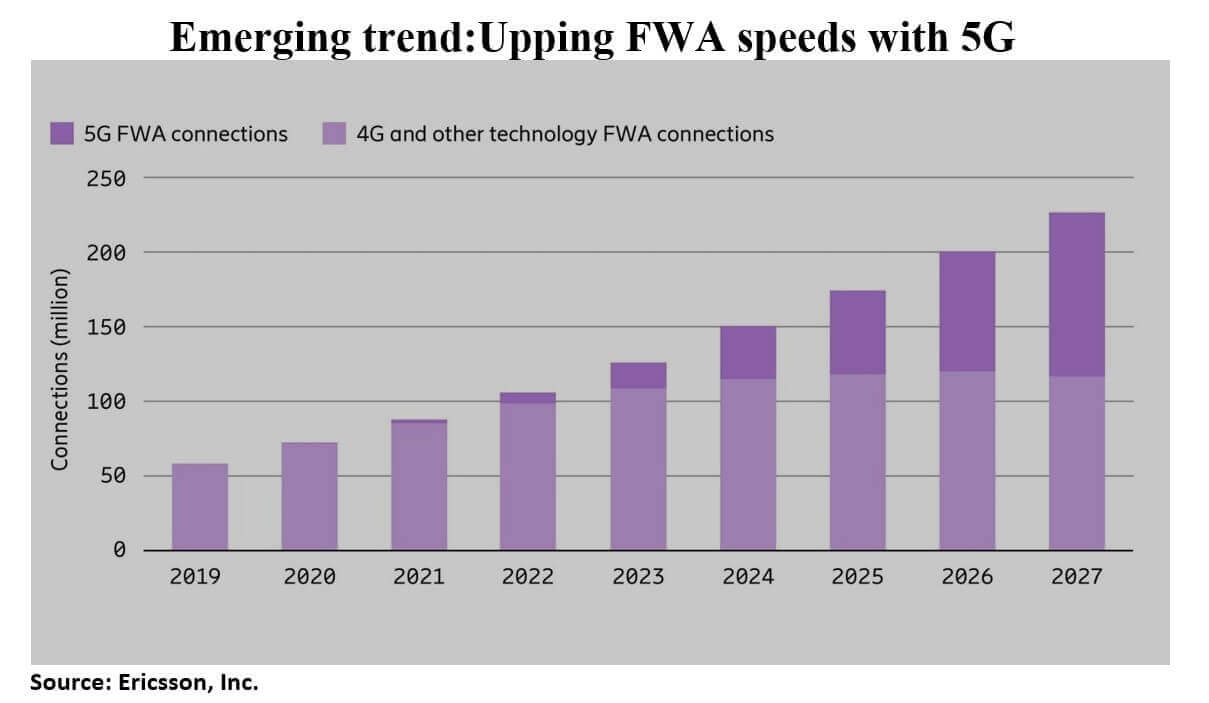Articles
Sample Articles from Bob Wallace.
Read More about Bob.
Will U.S. Businesses Leverage 5G in Canada?
- Details
- Published on 25 May 2022

(Source: Pixabay)
Expansion-minded U.S. enterprises, and those hurt by weak supply chain links, can find 5G-driven alternatives closer to home.
Hamstrung by Covid-disrupted supply chains, some U.S. businesses are looking to shorten and localize the systems. The answer for IT managers could be north of the border, where our second-largest trade partner Canada is also using 5G to create a digital economy.
But although the top 5 Canadian carriers are working to deploy 5G networks, they lag their counterparts here in the U.S., which can present challenges for enterprises looking to expand and enhance operations in Canada.
Know your neighbor
Be aware that Canada is all in on 5G and understands what it can do for the nation’s economy, with 5G networks estimated by GSMA Intelligence to deliver approximately $150 billion in additional value add to the country's economy from 2020 to 2040. The technology will play a crucial role in driving economic growth and supporting the recovery from the impact of Covid-19.
A makeover is in the works as 5G, with its faster connections (up to twenty times the speeds of 4G), increased network capacity (up to one hundred times the traffic capacity of 4G), and ultra-low latency alone portend to next-level Canada's top industries.
- Agriculture
- Energy
- Mining
- Automotive
- Banking
Top three exported goods pre-Covid:
- Energy products (worth $114 billion)
- Motor vehicles and motor vehicle parts ($93 billion)
- Consumer goods ($71 billion) – Source: Canadian Encyclopedia.
Know the lay of the land
The country’s geography features several large cities close to the U.S. border. The collective mass of the ten provinces and three northern territories is largely rural areas. Canada’s population, 38 million in 2020, is less than that of California.
Deployment costs: As stated by PWC Canada, the country’s smaller telecom industry prevents it from benefitting from the economies of scale enjoyed by carriers in the states. This could mean pricier network equipment and consumer devices.
Carrier competition/regulatory returns: With five key carriers deploying 5G in Canada, U.S. enterprise IT managers have greater choices for now. However, Rogers is working to acquire Shaw for $26 billion this year. Will more acquisitions follow as competition heightens?
Also of note is the fact that competition among these carriers is fierce whether providers are pressing regulators – the Canadian Radio-television and Telecommunications Commission (CRTC) - to block acquisitions and spending on spectrum purchases. This could slow deployments should the regulatory process get bogged down in disputes between the carriers. The CRTC greenlit the pending Rogers buyup of smaller Shaw earlier this year.
However, Canada's commissioner of competition intends to oppose Rogers’ proposed deal with Shaw, the companies said in a statement released in early May.
Regional vs. national: Canada is currently home to both, with Bell Canada providing country-wide service while smaller SaskTel focuses on its province (Saskatchewan). Concurrently, regional carrier Videotron (Quebec) recently spent $830 million on wireless spectrum it hopes to use to provide services across the country.
Private 5G networks
With the deployment of 5G in Canada about 18 months behind that of the U.S., businesses seeking to add sites north of the border could consider extending private 5G networks to these not yet served and remote locations, according to John Simcoe, Telecom, and Media Leader for PwC Canada. In areas that Canadian carriers plan to reach with 5G service, adding sites could be done using cross-carrier exchange agreements with U.S. carriers.
With one of three 5G spectrum auctions in Canada not yet completed, IT managers need to check to see that their networks /services in the U.S. use the same radio frequencies bands as those of Canadian carriers and private network providers, advises Simcoe.
Reaching rural sites: In the U.S., a combined $80 billion-plus has been approved for broadband deployment to close the digital divide (Rural Development Opportunity Funding), and the infrastructure and jobs bill from the Biden administration in the last year.
The investment in Canada started earlier but is far smaller. This could mean reaching unserved and underserved locations will be more expensive and take longer, and could present a losing proposition for service providers.
However, if the rural and remote locations happen to host businesses from top industries such as mining, oil, and transportation, it is a safe bet that these Canadian economic engines will be served early and completely by 5G services, emphasized PwC Canada’s Simcoe.
Canada started earlier, in 2016, on sizable infrastructure investments. It launched The Rural and northern stream of the Investing in Canada Infrastructure Program. The effort earmarked $2 billion over 10 years for priorities in small, rural, and remote communities spanning roads, broadband Internet connectivity, renewable energy, and facilities that support food security.
Canada added the Connect to Innovate: Rural and Remote Broadband effort to provide $500 million over five years, delivered by the Innovation, Science and Economic Development Canada program to extend and enhance broadband service in rural and remote communities. The funds were to bring high-speed Internet to 300 rural and remote communities.
Performance innovation – Standalone 5G nets
Rogers revealed in March that it has teamed with Ericsson to launch one of the first commercial 5G Standalone Networks (SA). The new service was activated after completing the rollout of Canada’s first national standalone 5G core.
With 5G core and 5G Radio Access Network (RAN) slicing, Rogers claims it can deliver new services to customers, such as dedicated private networks, public safety applications, and access to edge computing.
The carrier said that it has completed its 5G standalone core network deployment nationally and is deploying its 5G standalone service coverage in Montreal, Ottawa, Toronto, and Vancouver.
The SA difference
Simply stated, NSA makes it easier for network operators to deploy a 5G network as it can reuse current 4G facilities.
An important example of the difference between a 5G SA network and a 5G NSA system is that the former allows wireless customers with capable devices to connect to the 5G SA network. Such customers will automatically connect to the 5G SA service where it is available. The benefits are higher speeds and lower latency.
In contrast, 5G NSA mode networks rely on the 4G network facilities to provide more speed and higher data bandwidth. A 5G-enabled smartphone will connect to a 5G or 4G network, depending on conditions.
Device availability and certification
Because 5G deployment in Canada is proceeding at a slower pace than in the U.S., the list of available user devices is shorter. The good news is that Rogers has established a device certification program. Expect other carriers to follow suit as their 5G networks expand.
But with fewer vendors part of Canada’s telecom industry, U.S. IT managers might find a shorter list of supported devices for their use and workers’ use north of the border.
Rethinking trade and infrastructure
After two years of Covid-driven dysfunction and breakdowns in once-preferred global supply chains, rapid 5G deployments by close-by countries could receive greater consideration as IT managers evaluate adjustments and alternatives.
Canadian Carriers Chase the Digital Economy with Buyouts and 5G Investments
- Details
- Published on 24 May 2022

(Source: Pixabay)
These developments can help U.S.-based enterprise IT understand the business and technology of bringing 5G to offices and homes in Canada.
Canadian service providers Rogers, TELUS, Bell Canada, Videotron, and SaskTel, are rapidly deploying 5G networks to serve consumers and enterprises in a country with cities and vast rural expanses.
This may sound promising to IT managers at U.S. enterprises looking to establish or expand operations north of the border. But what must they consider in evaluating this opportunity?
Tough(er) sledding
Deploying 5G in Canada is far tougher than it is here in the U.S. And delayed 5G deployments threaten Canada’s global competitiveness. That is according to a report from PWC Canada.
The country's role has continued to grow since the North American Free Trade Agreement (NAFTA), signed into law in 1994, eliminated most tariffs between the trio of America, Canada, and Mexico and created a cross-continental trade bloc.
It is no surprise that the U.S. has become the largest goods importer in the world. U.S. goods imports from the world totaled $2.5 trillion in 2019 (pre-COVID 19), according to the Office of the United States Trade Representative. Canada, Mexico, and China are America’s three largest trading partners.
U.S.-based corporations such as automakers have moved the creation and assembly of products (and sourcing) north and south of America’s border to reduce labor and other costs.
PWC: Canada playing catch-up as size matters
In the digital economy, Canadian mobile network operators (MNOs) are negligible compared to their global peers and large multinational competitors, according to PWC Canada.
The three largest Canadian telcos generated, on average, approximately three and a half times less revenue than the leading telcos in the G7, South Korea and Australia. “Similarly, Canadian telcos are undersized compared to some of their main suppliers - significantly hampering their ability to negotiate better prices,” according to the global research firm’s report.
PWC Canada concludes that with the cost of delivering 5G forecast to be up to 71% higher than previous generations of connectivity, “the comparatively small scale of Canadian MNOs and their relatively higher network capital costs are likely to impact investments in the 5G connectivity required to enable the digital economy.”
Resulting acquisitions and big-ticket investments
Rogers acquires Shaw, accelerates 5G rollout
Plans to deploy 5G throughout multiple Canadian provinces came into focus in March as Rogers Communications announced and detailed plans to acquire rival Shaw Communications in a $26 billion transaction designed to accelerate the introduction of 5G in the country. The acquisition, which is expected to close in the first half of this year, will create the country's second-largest cellular and cable operator.
Western Canada is the target region for the introduction of the highest-speed wireless technology.
As part of the landmark acquisition, Rogers claimed it will invest $6.5 billion in Western Canada to build 5G networks, connect underserved rural areas and bring added choices to consumers and businesses. The innovative technology and network investments will create 3,000 net new jobs across Alberta, British Columbia, Manitoba, and Saskatchewan, Rogers added.
The deal has already received the necessary regulatory approval from the Canadian Radio-television and Telecommunications Commission (CRTC).
TELUS shows us
In addition to rolling out 5G in Canada, carrier TELUS is focusing on closing a digital divide in rural areas, which are more prevalent than in the U.S. For that tall task, the provider is employing fixed wireless access (FWA), which has taken something of a back seat to fiber in the U.S, to provide up to 100Mbit/sec Internet access to homes to power productivity.
In the U.S and far beyond, FWA is a quick-to-deploy and cheaper means than fiber to deliver broadband to remote offices and homes. TELUS provides its Smart Hub indoor CPE to complete the coveted high-speed connection over distances to un- and underserved areas.
TELUS has also spent heavily on fiber networking, investing $54 billion to connect 137 communities across B.C., Alberta, and parts of Quebec to its fast-expanding fiber-optic network.
In March, TELUS revealed a plan to bring broadband services to sixty communities spread across British Columbia and Alberta by yearend.
Bell Canada
Bell claimed it achieved its objective to offer 5G coverage for more than 70% of the Canadian population by the end of 2021. That included December turnups of Prince Edward Island with service in Charlottetown, Abram Village, Kensington, and Sherbrooke.
In early February, the carrier announced that 5G is now available in forty-two more communities in Ontario, Quebec, and Nova Scotia.
Videotron’s expansion plans
Videotron, a subsidiary of Quebecor Media, provides wired, wireless, and content services to businesses and consumers in Quebec. It has already rolled out 5G in Montreal and Quebec City.
The carrier is looking to offer services far beyond the boundaries of the province, having spent nearly $830 million in a wireless spectrum auction last July. The investment brought in 294 blocks of spectrum in the 3500 MHz band across the country.
More than half of the investment is concentrated in four Canadian provinces outside Quebec: southern and eastern Ontario, Manitoba, Alberta, and British Columbia. “The strategic investment positions Québec’s flagship carrier to realize its ambition of boosting healthy competition in telecom beyond the borders of Québec,” according to a press release.
Do not forget SaskTel
SaskTel provides wired and wireless services in the Canadian province of Saskatchewan. The carrier said it has been investing $95.9 million into wireless network enhancements, including $55 million on the initial rollout of 5G, in 2021-2022.
SaskTel says 5G is currently available in select locations. By the end of this year, 5G will cover approximately 50% of Saskatchewan's population, according to the company’s website.
Top Considerations for Enterprise Use of Fixed Wireless Access
- Details
- Published on 02 May 2022

(Source: Pixabay)
Carriers’ broadband deployment plans focus on fiber. But a growing number are also using FWA as well. What do IT managers need to know about the alternative to fiber as carrier decisions factor in your network expansion and enhancement plans?
Carriers’ broadband deployment plans focus on fiber. But a growing number are also using FWA as well. What do IT managers need to know about the alternative to fiber as carrier decisions factor in your network expansion and enhancement plans?
Why? While fiber can provide higher speeds, FWA is quicker to deploy, more reliable, and a cheaper means to provide high-speed Internet access in areas that lack broadband. In these scenarios, carriers cannot ROI-justify the time and cost of laying fiber or running it across phone poles to remote areas.
FWA is an increasingly attractive alternative to wired broadband Internet options at a time when carriers are looking to match the media with the population to ensure the service takes rates in their areas are sufficient to provide a profit and avoid a fiber bubble from overbuilding.
Broadband funding
The combined funding pool, which is approaching $100 billion, is fed by the FCC's Rural Digital Opportunity Fund (RDOF) and President Biden's $1.2 trillion Infrastructure Investment and Jobs Act (ARPA), which looks to bankroll the expansion of broadband throughout the nation.
Top considerations for IT managers
A sunny forecast. The economics and data rate performance of FWA are finally becoming competitive with that of wired internet services, according to Deloitte Global. The company predicts that the number of FWA connections will grow from about sixty million in 2020 to 88 million this year, with 5G FWA representing almost 7% of the total. “While our analysis reveals a 19% 2020–2026 CAGR in total FWA connections, 5G FWA connections will grow even faster, at a CAGR of almost 88%, over the same period,” wrote the authors of the Deloitte Insights report.
Deployment. If you are looking to quickly extend your corporate network to new locations such as small branch offices and remote workers in un or underserved areas such as rural regions, FWA is the answer since the radio frequency-based systems do not require digging, and the process carriers must go through for builds in municipalities. And do not forget winter weather in much of the U.S. as an impediment to digs for fiber.
FWA systems (typically point-to-multipoint) are above ground and can use different radio frequencies to deliver service to special CPE at the business or residence in an expedited manner.
Availability. With fiber, businesses risk service interruptions from cable cuts and damage from storms and car accidents to phone poles atop which the cables are often strung to speed rollouts, especially in rural areas. With carriers looking to use both media, compare SLAs for availability and other essential metrics such as mean time to repair.
Performance. In many cases, fiber systems can be upgraded to support higher speeds than FWA. But that does not mean the wireless option is not sufficient for the needs of potential network locations and WFH residences. FWA systems can support a wide range of speeds that exceed one hundred Mbps when supporting 5G technology.
A quickening ROI for carriers?
ROI-focused carriers are unlikely to use fiber to reach all unserved and underserved rural areas, opting for the quicker to deploy and less expensive FWA approach for home broadband.
Global carrier equipment maker Ericsson sees Fixed Wireless Access (FWA) as an efficient and scalable alternative to wired connections. "With smart and targeted deployments, our studies show that the investment typically pays off in less than two years." The vendor believes it can help its operator customers accelerate this in instances where 5G technology is used.
Over 75 percent of service providers now offer FWA. In October 2021, Ericsson, for the sixth time, updated its study of retail packages offered by service providers worldwide. Out of 312 service providers studied, 239 had an FWA offering, representing an average of 77 percent globally. Service providers’ adoption of FWA offerings has more than doubled in the last three years.
Looking ahead
How fixed wireless access is being offered: Ericsson survey says…Ericsson’s updated study of retail packages offered by service providers worldwide in October of last year provided important detail on how carriers structure FWA for their customers.
The majority (88 percent) of FWA offerings are best effort with a monthly volume tariff plan based on usage (GB/month), according to the survey. However, 12 percent of service providers respondents offer a QoS. Ericsson defines this as selling FWA services “with speed tiers, which it claims enables higher monetization, akin to how fiber-based broadband services are offered.”
Forty percent of these QoS offerings are basic, with average/typical speeds being advertised, the vendor added. "Some 60 percent are more advanced QoS offerings, involving speed tiers, such as 100Mbps, 300Mbps, and 500Mbps."
QoS in the U.S. Service providers with 5G fixed wireless access are more likely to have a QoS offering, with seventeen out of fifty-six utilizing this approach (30 percent), according to Ericsson global service provider survey. North America is the region with the highest adoption, with 40 percent of all offerings based on QoS.

FWA CPE prices fall, choices expand. It appears 5G FWA deployments are being driven by lower costs CPE, something Dell’Oro Group identified over a year ago. The cost for indoor 5G FWA CPE is expected to drop from $475 in 2020 to $180 by the end of 2023.
“The global demand for broadband service has resulted in an acceleration of interest among fixed and mobile operators alike to either expand their existing LTE or point-to-multipoint fixed wireless access (FWA) offerings or roll out early 5G FWA services to a growing base of current and potential subscribers,” explained Jeff Heynen, Vice President, Broadband Access and Home Networking at Dell’Oro Group, a market research and analysis firm.
What Enterprises Can Expect as Carriers to Spend Billions on Broadband Rollouts
- Details
- Published on 19 April 2022

(Source: Pixabay)
From funding to the front door, IT managers can learn from state-level fiber expansions and benefit from programs created to speed high-speed Internet buildouts powered by federal legislation, the FCC, and annual carrier capital expenditures.
The knock on the door might not be a marketer asking you to sign up for solar panels. Instead, it may be a door-to-door salesperson pitching broadband Internet from a provider you may not have heard of.
AT&T and Google Fiber have confirmed that they are taking it to the streets in an aggressive effort to sell fiber-based products in newly entered areas and against entrenched incumbent telcos and cable companies.
The fiber forays will deliver high-speed Internet service to support work-from-home efforts, virtual education, telemedicine, streaming services, and gaming.
Funding fuels deployments
Why the full-court press? Flush with grants and funding from the American Rescue Plan, the Rural Development Opportunity Fund (RDOF), and Infrastructure Investment and Jobs Act, added to annual carrier CapEx spending, the broadband breakout is well underway.
Carriers large and small are aggressively upgrading and expanding their networks to offer faster services and to un- and underserved areas to take on cable incumbents such as cableco Charter, who are also adding fiber.
Fiber forecast and IT guidance
It is anticipated that annual spending on fiber upgrades and expansions will continue for at least five years before the broadband breakout slows. Enterprise IT managers need to be aware of new and emerging efforts embraced by states and carriers to drive fiber deployments.
IT manager prep
With many service providers of all types – new and old - having stated their plans and associated timelines, there is not much IT managers can do to influence the actual speed of fiber service rollouts. But by understanding emerging efforts to drive the use of funds for broadband deployment, they can get up to speed before they get new or faster broadband speeds.
“IT managers will want to do their homework and make sure to fully vet new providers to make sure they aren’t overextending themselves and also trying to boost take rates by offering SLA guarantees they can’t necessarily back up,” advises Jeff Heynen, Vice President, Broadband Access and Home Networking at Dell’Oro Group, a market research and analysis firm.
AT&T operational challenges
Speaking on an earnings call, AT&T CEO John Stankey said it takes a year from the time it begins engineering work in a new market to the time it can start selling fiber products there.
AT&T’s stated goal is to cut that timeframe down “substantially” so it can get its broadband products to consumers faster. The carrier lost 20,000 broadband customers in Q4 2021 as fiber net additions failed to offset DSL and non-fiber losses.
The type of things to come
AT&T plans to double its fiber footprint by 2025. That should help the telco in its ongoing rollout of gigabit services (including multi) and increasingly popular symmetrical services to better compete with cablecos (pushing DOCSIS 4.0) for all-size enterprise business and consumer connections. It will also drive support for an expanded 5G wireless network.
Supply chain challenges notwithstanding, the fiber network will cover four million small businesses and one million enterprise locations, and more than twenty-five million consumer locations with multi-gig performance, according to Jeff McElfresh, CEO of AT&T Communications. “Nationwide, more than 9.5 million business customer locations are within 1,000 feet of our fiber.” The carrier exec said that he believes AT&T has enough “weight” in the industry that it can work with vendors to overcome any supply chain delays.
Addressing the skills gap- Optical installers get smarter, faster
The Fiber Broadband Association (FBA) recently launched an Optical Telecom Installation Certification program to help scale the education of fiber technicians, with a pilot run that was set to start on March 29.
Fiber broadband experts designed the program to quickly scale fiber technician education to fill the existing fiber skills gap and accelerate fiber deployments across North America.
The FBA forecasts that more fiber will be deployed in the next five years than has been deployed in the past 20 years, but the need for skilled fiber optic technicians will significantly impact each state’s ability to deploy broadband. The FBA’s OpTIC program teaches the knowledge and skills required to properly install, test, and maintain high-speed fiber broadband networks.
"When we saw the need for an expanded fiber workforce in order to keep up with broadband demand and growth opportunities, we began development of this intensive training program to ensure that no state is left behind in the digital equity gap," said Deborah Kish, Vice President of Research and Workforce Development at the FBA.
The FBA is engaged with twenty-three states to roll out this fiber optic technician training program with their community college systems and fiber optic broadband service providers. Its stated goal is to reach all fifty states and U.S. territories by the end of the year.
Build, own and lease to ISPs - Michigan
One such option IT managers need to be aware of is for county utilities to use the funding to build new fiber and wireless networks, which they would own, and leaseback to ISPs to speed the introduction of broadband services throughout the county.
Michigan's Ottawa County is exploring this opportunity, having built cell towers for wireless services this way before and then leased them to companies to cover dead zones in the town. It was not economically feasible at the time for companies to build that infrastructure, and a similar situation has been playing out with internet infrastructure in sparsely populated rural areas of the county.
“It is not economically feasible to lay fiber to every home and business across the county,” said Douglas Weber, president of Urban Wireless Solutions, Ottawa County’s consultant on the initiative. “If it were, you would have seen all the major internet service providers doing so already. Furthermore, wireless technology has improved to the point where it is delivering internet speeds comparable to fiber and can be deployed in a more economically prudent manner.”
The statewide grant approach with rules - Tennessee
The State of Tennessee detailed in March a plan to spend $400 million in federal funds from the American Rescue Plan for carriers to deliver broadband services in the state. The entities can be solely broadband providers to Tennessee, or they can include nationwide coverage. Broadband infrastructure projects in Tennessee will prioritize "severely underserved" communities, which it defines as serving those that have coverage below 25/3 Mbps and 10/1 Mbps.
The Tennessee Department of Economic and Community Development (ECD) broadband providers had until mid-March 15 to submit applications for funding. Projects must be completed within three years. The additional funding from the ARP has allowed the state entity to waive its $2 million maximum request amount for grants.
Too fast and furious?
One aspect for IT managers to consider is that in a race to reach new areas and provide a competitive alternative to businesses and consumers, providers may overextend themselves financially.
Does the demand justify new fiber builds to attract customers’ whose collective spend does not cost-justify the rollouts?
“The key part of their analysis is that there is [plenty] of overbuilding going on right now. In other words, expansions into new areas to try to grab broadband subscribers away from incumbent providers,” explained Dell’Oro’s Heynen. “Operators are using the high valuations of their fiber networks to secure more funding to cover these expansion projects. Because of that, I do agree that traditional take rate assumptions might be a bit rosy.”
For the foreseeable future, service providers see fiber rollouts as an opportunity knocking loudly.
Private 5G Networks Sector Surges with New Services, Investments, and User Trials
- Details
- Published on 19 April 2022

(Source: Pixabay)
Enterprises face a fast-expanding array of 5G private network offerings as AWS, Cisco, HPE, and others have joined the fray since December.
What a difference three months has made. While momentum is building fast for private 5G network services for enterprise use, it is unclear if organizations fully understand the technologies involved and their value. In fact, IT managers are still learning how the offerings can help their operations and get them up and running.
Concurrently, the carrier and vendor ecosystem is faced with finding ways to monetize their private 5G networks offerings.
But this does not mean a doom and gloom forecast for one of the hottest and most dynamic sectors in networking. It is quite the opposite.
This nascent industry segment is expanding rapidly, with the entrance of tech giants to the provider roster in the last several months, a continuous infusion of funding, and enterprises trialing 5G networks as a step that can lead to commercial implementations.
Targeting wired Ethernet, Wi-Fi
Private 5G service providers are targeting enterprises that currently use wired Ethernet LANs (hard to install and manage) and Wi-Fi (which presents coverage issues) in their corporate networks. Using a private 5G network service can solve these challenges while providing ultra-low latency.
What do enterprise IT managers need to know about escalating activity in the burgeoning sector to evaluate a widening array of offerings and opportunities?
The entry of network computing giants in recent months should have IT managers reviewing private 5G network offerings for such use cases as shipping and delivery fleets, tablets in factories and warehouses, and robotic manufacturing, said AWS Adam CEO Selipsky at an annual company event late last year. “All these new use cases require consistent, reliable connectivity.”
Private 5G draws a big crowd
Until recently, the private 5G market has included few telecommunications system behemoths along with lesser-known innovators that are battling to get the attention of enterprise customers.
But starting last December, tech giants joined the fray, expanding the menu of private 5G network providers and more choices for IT managers.
Early entrants: Verizon and Betacom
Since then (in last few months): Amazon Web Services, Cisco Systems, and HPE.).
At Mobile World Congress (MWC) in Barcelona, AT&T outlined an effort with Microsoft to develop a service called Private AT&T Edge that includes the ability to roam beyond the geographical boundaries of the AT&T private network and still stay connected through the AT&T public network.
Pre-integrated solutions
Availability of pre-integrated solutions portends to simplify private 5G networks for enterprises. Qualcomm’s partner program aims at that goal. The tech giant is working with Microsoft to offer such an offering in the third quarter of this year. This and others will be available through select operators and integrators.
Now targeting SMBs
Also at the show, Verizon announced a turnkey solution that partner Celona will bring to market. This solution is for small- and medium-sized enterprises “looking for fast time-to-value,” according to the carrier.
The offering from Celona is designed to expand the target market of customers. It will be usable with CBRS spectrum, according to the vendor.
Investing in 5G: follow the money
In an emerging market, tracking investments in non-household names can give IT managers a better understanding of the infrastructure that can provide broader networking opportunities. In this case, Federated Wireless last month secured $58 million in Series D funding. This brings Federated’s total funding raised to $210 million. Federated was founded last year.
Adding CBRS spectrum inventory
What is Federated? It makes spectrum access systems (SAS) that allow companies to use shared spectrum in the 3.5Ghz band for 5G networks without interference issues.
This spectrum administration offering became crucial as the FCC auctions spectrum in the Citizens Band Radio Service (CBRS) to all comers, with buyers including Deere Co., utilities, rural telcos, and large universities. The auction ended in August 2020 and generated over $4.5 billion. CBRS expanded 5G private network opportunities to provide additional inventory for enterprises, carriers, and other organizations.
From trials to implementations – and traction?
Since trials precede implementations, enterprise IT managers can learn from the experiences of others, especially with a new or emerging technology. Here is a case in point: Longtime wireless network builder for carriers for Betacom Inc. launched a fully managed private 5G network service in late May. The company handles network design, deployment, and management for the offering. Betacom explains enterprise customers retain ownership of the network and local control of their data. Management is provided from its NOC, which is hosted on Microsoft Azure.
Just last month, Betacom announced a service trial with the Dallas Fort Worth (DFW) Airport, explaining that it is “trialing a private 5G network for increased baggage handling accuracy and efficiency. Betacom claims is 5G-as-a-service allows DFW to “securely run their mission-critical applications without interference and helps to speed up baggage handling and reduce lost baggage costs.”
Verizon, which launched its private 5G service last June, revealed during Mobile World Congress in Barcelona that it has landed its first commercial customer, the new headquarters of BlackRock in New York City. The carrier says the effort brings 5G Ultra Wideband connectivity to areas of BlackRock’s new Hudson Yards facility where high speed and low latency will be required in its trading floor, conference center, auditorium, and meeting rooms.
The road ahead
With carriers, equipment vendors, and integrators rolling out private 5G network offerings at a rapid pace, enterprise IT interested in this technology will find themselves awash in offerings to compare in 2022 and far beyond.
This, of course, is as providers settle on monetization strategies necessary for enterprises to determine the value of implementing 5G technology in their business operations.
Five CDN Trends for Enterprises to Track
- Details
- Published on 21 March 2022

(Source: Pixabay)
Soaring video traffic, WFH, and security service acquisitions drive content delivery sector expansion as core functions enrich the network edge.
Content Delivery Networks (CDN) have come a long way since the creation of the service provider category at the turn of the century during the wild west days of e-commerce websites and video delivery.
Witness the rapid expansion of the CDN market in the last few years, which saw cloud computing giants such as Google, Microsoft, and Amazon join pioneers such as Akamai Technologies, Limelight Networks, and Mirror Image. Some early players were acquired by telcos. Fastly and Cloudflare are more recent entrants.
What is a CDN?
A CDN is basically a global collection of servers that speed delivery of web content by bringing it closer to users. Data centers use caching, a process that temporarily stores copies of files so that users can access Internet content from a web device or browser more quickly through a server near you. Cached content includes web pages, images, and video in proxy servers nearest users. The far shorter routes from origin to destination also save bandwidth, boosting performance and cutting costs.
Global video volume climbs
The sheer volume of video as a percent of total global network traffic is continuing to soar, with Cisco’s video forecast claiming that IP video would be 82% of all IP traffic in 2021, up from 73% in 2016. Globally, Ultra HD will be 20.7% of IP Video traffic in 2021, up from 1.8% in 2016.
CDN providers are now more in demand than ever. The unmatched surge in popularity of streaming services, social networks, and online gaming (in no small part thanks to the global pandemic) has significantly increased the load on data centers.
CDN uses flourish
Today, Content Delivery Network (CDN) operators are chasing business in security services, mobile apps, gaming software delivery, and firmware updates as part of a fast-growing list of use cases -all while supporting the burgeoning streaming video TV services. And don’t forget helping handle the quick switch to mass working from home daily.
Trending; the top 5
So, what emerging and advancing trends should IT managers track with cloud CDN providers in 2022?
1) Fast-growing CDN roster, and possible consolidation?
Not long ago, the lineup featured pioneer Akamai, with rivals Limelight Networks, Level 3 Communications, Edgecast Networks, Mirror Image, CDNetworks, and more. But telcos snapped up and assimilated some of these players to offer CDN functionality to their customers.
But instead of the sector lineup shrinking, Cloud computing giants Google, Amazon, and Microsoft launched robust CDN offerings to businesses of all sizes, all built on their global computing and distribution networks. Fastly and Cloudflare also joined in with innovative services. Bottom line: The more, the merrier.
2) Expanding security focus
Early CDNs were designed to help enterprise customers’ website operations withstand heavy, often unanticipated, traffic volume and DDoS attacks by distributing requests for content across their sprawling networks. This continues today, but we’ve seen CDN operators such as Akamai offer add-on security services for their customers -spending $1.5 billion in the last year- an emerging trend for IT managers to keep a watchful eye on.
- Last month, Akamai announced plans to buy Linode, a provider of core cloud services for developers, for $900 million. Linode’s services include compute, block and object storage, managed database, load balancers, and a managed Kubernetes offering that supports running containerized applications.
- Last September, the CDN operator announced plans to buy Guardicore, a maker of micro-segmentation solutions, for $600 million. By adding its solution into Akamai’s Zero Trust security lineup, the operator claimed it would be uniquely suited to supply comprehensive protections to the enterprise, defending against threat actors and the spread of malware and ransomware.
- Roughly a year ago, Akamai purchased Inverse to better identify IoT and mobile devices, including Internet-connected HVAC, lighting systems, robotics, medical gear, and printers in organizations.
- In its Q4 2021 earnings call last month, Akamai CEO Tom Leighton said that security products continued their rapid growth, generating revenue of $365 million, up 23% year-over-year. “For the full year, security revenue reached $1.33 billion and grew 26% over 2020. Security represented 39% of our revenue last year, up from 33% in 2020.”
In the overall CDN sector, the security type menu has expanded far beyond DDoS attack protection to include:
- Web Application Firewall
- Bot Mitigation & Screen Scraping Protection
- Data Security
- DNS Protection
3) The edge fuels WFH
CDNs are becoming a top driver and use case for edge computing. How? Well, while the delivery of content from edge devices as close to customers as possible is largely the same approach providers used in moving content closer to end-user devices, and for the same reasons. Cloud CDN players are adding more functionality, such as processing power, to the increasingly intelligent network edge.
The architecture of CDNs is playing a leading role in supporting work-from-home implementations. After all, early CDNs were built on edge computing functionality long before the phrase edge computing was coined.
4) CDN or CDNs?
Enterprises looking to live stream video require far more functionality for their events, be the audience national or global. In fact, organizations in the live group have been known to use multiple CDNs (one as a primary and the other as a backup) if the primary suffers performance issues or outages.
Advanced software packages from firms such as Conviva enable a customer to switch back and forth in real time between CDNs to ensure the best view experience. This is also important if ISP capacity issues arise, and the content needs to be downshifted to a slower bandwidth to be delivered on time. Also, CDNs are stronger coverage-wise in some states (U.S.), regions, countries, and continents than in others.
5) Build vs. buy
There was a time when large companies considered and built their own CDN networks rather than relying on services from established providers. One such content streamer, Netflix, began to build a worldwide CDN, which the company claims has cost over $1 billion, to ensure the movie, series, and shows in its pioneering subscription video-on-demand streaming service are located as close as possible to its customers with the quickest loading times possible.
The Walt Disney Company, which launched its own subscription services internationally to compete with Netflix and a widening field of rivals, spent a few billion dollars in 2017 and 2018 to buy a majority stake (estimated at 85%) in BAMTech LLC.
Major League Baseball created the streaming tech company in 2015. That gave Disney the CDN and related assets needed to quickly launch ESPN streaming services and its Disney+ consumer streaming service in late 2019.
The bottom line
With the live-streamed Super Bowl and Winter Olympics in the rearview mirror and March Madness upon us, it’s easy to overlook the increasing CDN use by enterprises of all sizes outside the media and entertainment vertical.
The key takeaway in tracking CDN trends is the breadth of their use far beyond streaming video. Microsoft uses CDNs to cache static assets of its Office 365 software suite closer to the browsers requesting them to speed up downloads and reduce perceived end-user latency. Meanwhile, SMBs now use CDNs to support WFH applications. IT departments use CDNs to distribute product updates.
